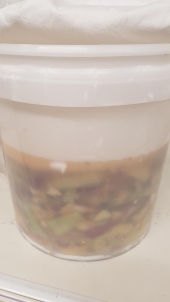posted 7 years ago
The apples contain sugar, the yeast, natural yeast if you don't add any will make the sugar into alcohol. That makes gas appear, just like making wine, the bubbles in the airlock on top of a closed vessel are CO2, produced by the yeast. The CO2 pushes out all the oxygen, so the wine/cider dousn't sour.
If you add O2(oxygen) wine or cider will get sour, thats because acetic acid bacteria change the alcohol into "sourness", acetic acid. Vin means wine in french and aigre means sour. Vinaigre is sour wine. Leave wine without a cork in time it will become vin aigre or vinegar.
So two types of micro organisms have to be present to make apple cider vinegar. Both of them just float through the air and will come onto fruit and start doing their job. Together they form this mother which is a handy thing because you can move it to speed the two processes up.
That's the theory behind it.
I been doing it three years now. I cut the apples in pieces of 1 inch or whatever, remove the seeds and heart of the apple. Chuck it in a pan, pour water on it, put a cloth over the pan and make sure it is tight, so fruitflies can't come in. This year they did, it was a big mess with tiny larvae munching the apples, pops, hundreds of fruitflies. I made a brand new batch and kept it in a closed cupboard, far away from evil Drosophia.
And the best thing ever was that i read you can add herbs, and i did went to the herb patch, got dragon, it's so good it's just unbelievable how good that is. I shouldn't have shared it with you apple cider vinegar newbies in fact. But i have, because it's sooo good.
Creating edible biodiversity and embracing everlasting abundance.

 2
2




 2
2




 1
1




 2
2








 1
1




 2
2









